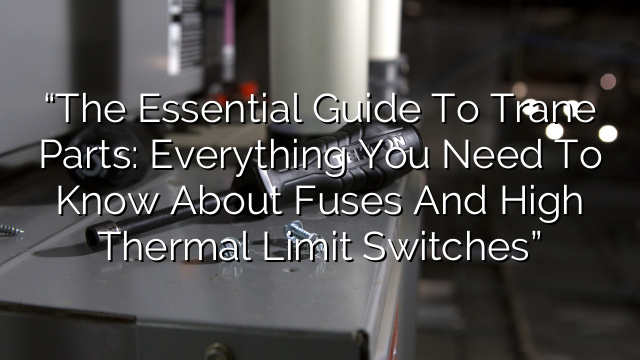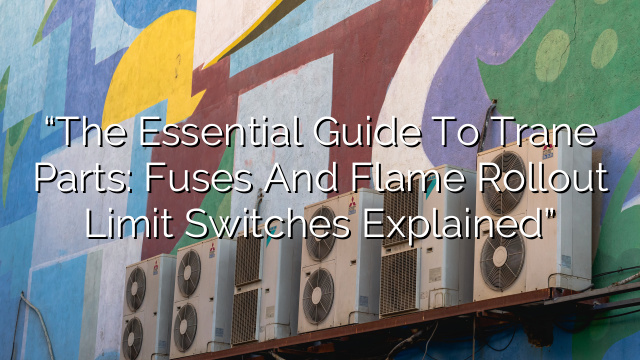Introduction
Welcome to “The Ultimate Guide to Trane Parts: Everything You Need to Know About Fuses and Thermal Limit Switches.” If you own a Trane HVAC system, it is essential to understand the components that make it work efficiently. In this guide, we will focus on Trane fuses and thermal limit switches, explaining their functions, types, and how to troubleshoot common issues. Let’s dive in!
Trane Fuses
Trane fuses are safety devices designed to protect your HVAC system from electrical faults and overheating. They are commonly used in both residential and commercial Trane units. When an electrical overload occurs, the fuse will blow, interrupting the circuit and preventing further damage.
Types of Trane Fuses
Trane offers various types of fuses for different applications. Some of the most common types include:
- Glass Tube Fuses: These fuses feature a glass tube with a metal cap at each end. They are commonly used in older Trane units.
- Cartridge Fuses: Cartridge fuses consist of a ceramic or fiberglass tube and two metal endcaps. They are available in different sizes and amperages to meet the specific requirements of your Trane system.
- Blade Fuses: Blade fuses, also known as plug-in fuses, are the most commonly used fuses in modern Trane units. They are easy to install and replace, thanks to their compact design.
Thermal Limit Switches
Thermal limit switches, also referred to as high limit switches, are safety devices used to prevent your Trane system from overheating. They are installed in strategic locations within the system and monitor the temperature. If the temperature exceeds a preset limit, the thermal limit switch will shut off the furnace or air conditioner, preventing damage to the system.
Types of Thermal Limit Switches
Trane offers different types of thermal limit switches based on their applications and temperature ratings. Some common types include:
- Bimetal Disc Switches: These switches consist of a bimetallic disc that flexes with temperature changes. When the temperature exceeds the designed limit, the disc snaps and breaks the electrical circuit.
- Rod and Tube Switches: Rod and tube switches use a metal rod that expands or contracts with temperature changes. When the rod reaches a certain length due to expansion, it triggers the switch and interrupts the circuit.
- Automatic Reset Switches: Automatic reset switches are self-healing switches that automatically reset once the temperature returns to normal. They are commonly used in heating systems.
Troubleshooting Common Issues
If you are experiencing issues with your Trane fuses or thermal limit switches, here are some troubleshooting steps you can take:
- Fuse Issues:
- Check if the fuse is blown by visually inspecting it. If the fuse is blackened or has a broken filament, it needs to be replaced.
- Make sure to replace the blown fuse with one of the same type and rating to maintain system safety.
- If the fuse keeps blowing, it may indicate a larger electrical problem. In this case, it is advisable to call a professional Trane technician to diagnose and resolve the issue.
- Thermal Limit Switch Issues:
- Ensure that the temperature around the thermal limit switch is within the operating range mentioned in the system’s manual.
- Check for any visible damage or signs of overheating on the thermal limit switch. If any issues are found, it may need to be replaced.
- If the thermal limit switch is constantly tripping, it could be due to restricted airflow or a malfunctioning component. Contact a Trane technician to identify and fix the underlying problem.
Frequently Asked Questions (FAQs)
Q1: Are Trane fuses and thermal limit switches interchangeable with other brands?
No, Trane fuses and thermal limit switches are specifically designed for Trane HVAC systems. It is crucial to use genuine Trane parts to maintain optimal performance and ensure compatibility.
Q2: Can I replace a blown fuse or thermal limit switch myself?
While fuse replacement can be a DIY task, it is recommended to hire a professional Trane technician to perform the replacement or repair of thermal limit switches. This ensures proper installation and avoids any safety risks.
Q3: How often should I check my Trane fuses and thermal limit switches?
It is recommended to have your Trane system inspected annually by a qualified technician. During routine maintenance, they will check the condition and functionality of the fuses and thermal limit switches.
Q4: What happens if I ignore a blown fuse or a malfunctioning thermal limit switch?
Ignoring a blown fuse or a malfunctioning thermal limit switch can lead to further damage to your Trane system, such as electrical issues, overheating, or even complete system failure. It is important to address these issues promptly to avoid more extensive repairs.
Q5: Where can I purchase genuine Trane fuses and thermal limit switches?
You can purchase genuine Trane fuses and thermal limit switches from authorized Trane dealers or trusted HVAC part suppliers. It is recommended to avoid purchasing from unknown sources to ensure quality and compatibility.
Conclusion
Understanding Trane fuses and thermal limit switches is essential for maintaining the performance and safety of your Trane HVAC system. Remember, if you encounter any issues or are unsure about the replacement process, it’s best to consult a professional Trane technician who can provide expert advice and assistance.










